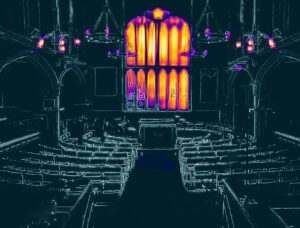No products in the basket.
Halo Church Heating at St Matthews
Background
St Matthews Church was looking for an electric heating solution so that it could move off fossil fuels and replace its gas heating system, in line with the Church of England target to achieve net zero carbon by 2030.
They were keen to trial the Halo (Registered UK Design No. 6321585) church heating solution from Herschel and heat the congregation whilst seated for service in the large nave. The Halo heater was specified for St Matthews Church by our specialist Heritage Team.
Winter 2022: Watch Andrew Wood’s Halo testimonial and our thermal imaging footage showcasing the temperature effect and speed with which the heated zone gets to the required temperature.
Solution
St Matthews is typical of many churches with a beautiful, spacious interior and high ceilings alongside stunning stained glass windows and historic foundations which need to be preserved. Four Halo 7.8kW heaters were installed, a bespoke radiant chandelier heater which has been specially designed to fit in to the heritage aesthetic and ensure the preservation of interiors is maintained.
 The church did consider both air source heat pumps and ground source, both of which were dismissed. The air source heat pump would require additional top up in the colder winter months whilst the ground source heat pump involved substantial costs alongside the risk that it may not be proceedable.
The church did consider both air source heat pumps and ground source, both of which were dismissed. The air source heat pump would require additional top up in the colder winter months whilst the ground source heat pump involved substantial costs alongside the risk that it may not be proceedable.
The Halo church heating was installed in September 2022 and was run over the full winter season to monitor energy consumption, costs and comfort. The installation was carried out in one day. We met up with Andrew Wood, Treasurer, who shared his feedback on how the Halos have worked in heating the congregation both in terms of managing comfort levels and energy consumption.
Comfort Levels
Andrew outlines how the congregation has “felt really warm throughout the coldest months back in January/February”. He describes how the Halo church heating “have a three-stage heat setting, so at the beginning back in November time, when it wasn’t quite so cold, we had it on the middle setting and then in the colder months in January/February we had it on the full setting and again just instant. If it’s not quite warm enough, then you instantly turn it up to a higher level so it’s just fantastic in terms of the flexibility”.
Energy Consumption
The church does not use the boiler system at all for their Sunday morning worships, only using the radiant heaters for warmth.
“The great thing about the heaters is they’re just instant so we turn them on five or ten minutes before the service starts so they are literally on or off and instant, so you feel the immediate benefit”.
With the previous gas heating the church was having to run this for a couple of hours before the Sunday service started at 10:30am in order to allow it to get up to temperature. The church has a “vast roof space, so all of that had to be heated before the heat got down to seat level. So just completely different, instant compared with having to turn something on two hours beforehand”.
£10 a Sunday service
“The radiant heaters, which we now use entirely and have done throughout the winter period for our Sunday morning worship services, is only about £10 for an hour and a half to two hours on a Sunday morning. It is so low that it’s a no-brainer if I may say that we should use the radiant heaters”.
Speed of Warm Up – Thermal Imagery
We took our thermal imaging camera along to St Matthews in March to monitor the temperatures before and after the Halo church heaters were switched on within the congregational space. The above video displays a timelapse showing how the heated zone experienced a sharp and significant rise in temperature and the photos below illustrate the amazing results achieved from the Halo heaters. In just 5 minutes, the temperature had already increased from 11°C to 18°C, and after only 20 minutes, the heated zone measured at a comfortable 22°C. By emitting a bubble of radiant heating over the congregation rather than heating the huge volume of air within the church interior, the Halo is able to quickly and comfortably warm the occupiers of the space and save energy.
Using the latest technology, our Heritage specification service includes 3D scans of our heritage heaters within churches and other historic buildings. Take a look at St Matthew’s Church here, click and scroll your way through to navigate the beautiful interior.
St Matthew’s Church is now extending the installation of Herschel’s radiant heaters to other areas within the church.
Halo church heating emits a bubble of radiant heat


The St Matthews install is a fantastic example of what our innovative heating technology can deliver, in terms of comfort, reduced energy consumption and emissions as well as being a being a more practical alternative to heat pumps with lower upfront capital costs. The Herschel Infrared Halo heaters provide an efficient, sustainable, non-intrusive and comfortable radiant heating solution for churches, places of worship and other large historical buildings and is available now. Contact the Herschel Heritage Team today for a free consultation and experience the future of church heating for yourself.





